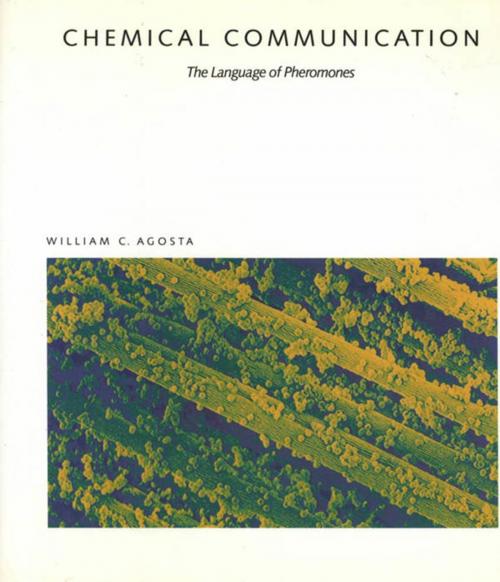Chemical Communication
The Language Of Pheromones
Nonfiction, Science & Nature, Science, Chemistry, Organic, Biological Sciences, Biology| Author: | William C. Agosta | ISBN: | 9781466813939 |
| Publisher: | Henry Holt and Co. | Publication: | April 15, 1992 |
| Imprint: | Henry Holt and Co. | Language: | English |
| Author: | William C. Agosta |
| ISBN: | 9781466813939 |
| Publisher: | Henry Holt and Co. |
| Publication: | April 15, 1992 |
| Imprint: | Henry Holt and Co. |
| Language: | English |
A wounded minnow attempts to rejoin its school and the other minnows scatter in panic; a single beetle finds a pine tree to its liking and soon thousands of beetles swarm that tree and others in the vicinity; a male Syrian golden hamster is drawn along an invisible trail to a burrow where a female hamster awaits him, ready for mating. These animals are responding to received communications, but, as in countless other occurrences in nature, the language is not auditory or visual--it is chemical.
Unlike humans, who gather information largely through sight and sound, most living creatures rely heavily on chemical compounds from other organisms for their basic knowledge of the world. Among the various types of these compounds are the chemical signals exchanged between members of the same species that govern social interactions crucial to survival. These signals are called pheromones (from the Greek "pherein"--to carry--and "hormon"--exciting) and they are used to send warnings, establish territorial boundaries, provoke aggression, control sexual behavior, and locate food. In this volume, organic chemist William C. Agosta explores the chemistry of pheromones and the mechanisms by which they orchestrate animal behavior. Professor Agosta details the intricate process of identifying pheromones and determining the active components within these sometimes highly complex mixtures. He also demonstrates the value of this growing body of knowledge to our understanding of evolution, ecology, human behavior, and agricultural production. The result is a fascinating look at a research area that brings together investigators, information, technologies, and procedures from the fields of biology, chemistry, and behavioral science.
Chemical Communication spans the entire spectrum of life, from simple organisms, such as water molds and brown algae, to insects, birds, fish, reptiles, mammals, and in a provocative final chapter, human beings. Along the way, Dr. Agosta provides dozens of captivating examples of pheromones in action: certain male red-sided garter snakes, which increase their chances of mating successfully by "impersonating" a female, thus distracting rivals; or the bolas spiders, which capture male moths by hitting them with an adhesive ball on a string after emitting a female moth pheromone that lures the males within range. The book also includes important evidence that pheromones alter physiology as well as behavior. For example, young female mice reach maturity at an accelerated pace after constant exposure to adult male mice.
A wounded minnow attempts to rejoin its school and the other minnows scatter in panic; a single beetle finds a pine tree to its liking and soon thousands of beetles swarm that tree and others in the vicinity; a male Syrian golden hamster is drawn along an invisible trail to a burrow where a female hamster awaits him, ready for mating. These animals are responding to received communications, but, as in countless other occurrences in nature, the language is not auditory or visual--it is chemical.
Unlike humans, who gather information largely through sight and sound, most living creatures rely heavily on chemical compounds from other organisms for their basic knowledge of the world. Among the various types of these compounds are the chemical signals exchanged between members of the same species that govern social interactions crucial to survival. These signals are called pheromones (from the Greek "pherein"--to carry--and "hormon"--exciting) and they are used to send warnings, establish territorial boundaries, provoke aggression, control sexual behavior, and locate food. In this volume, organic chemist William C. Agosta explores the chemistry of pheromones and the mechanisms by which they orchestrate animal behavior. Professor Agosta details the intricate process of identifying pheromones and determining the active components within these sometimes highly complex mixtures. He also demonstrates the value of this growing body of knowledge to our understanding of evolution, ecology, human behavior, and agricultural production. The result is a fascinating look at a research area that brings together investigators, information, technologies, and procedures from the fields of biology, chemistry, and behavioral science.
Chemical Communication spans the entire spectrum of life, from simple organisms, such as water molds and brown algae, to insects, birds, fish, reptiles, mammals, and in a provocative final chapter, human beings. Along the way, Dr. Agosta provides dozens of captivating examples of pheromones in action: certain male red-sided garter snakes, which increase their chances of mating successfully by "impersonating" a female, thus distracting rivals; or the bolas spiders, which capture male moths by hitting them with an adhesive ball on a string after emitting a female moth pheromone that lures the males within range. The book also includes important evidence that pheromones alter physiology as well as behavior. For example, young female mice reach maturity at an accelerated pace after constant exposure to adult male mice.















